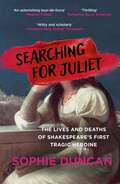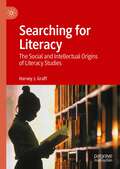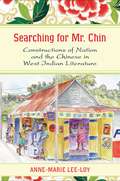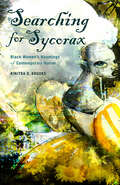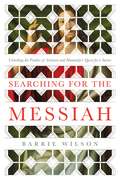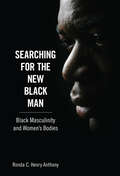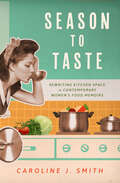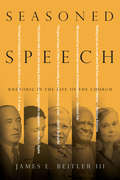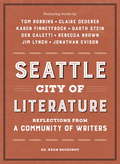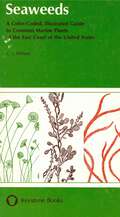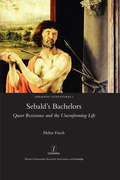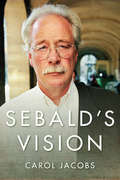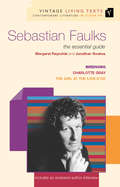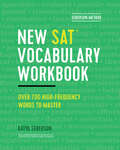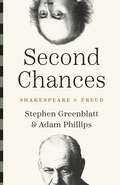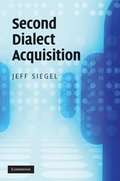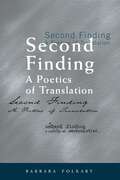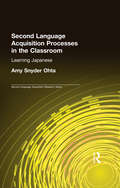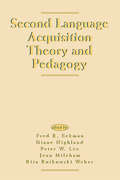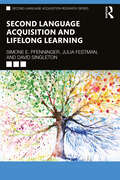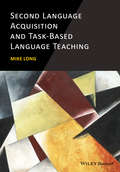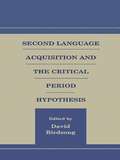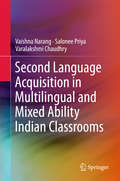- Table View
- List View
Searching for Juliet: The Lives and Deaths of Shakespeare's First Tragic Heroine
by Sophie Duncan'Witty and scholarly'JONATHAN BATE, SUNDAY TELEGRAPH'Thrilling'GUARDIAN'Illuminating . . . as vital and provocative as the character herself'LITERARY REVIEW'Buoyant'TIMES LITERARY SUPPLEMENT'An astonishing tour-de-force'MARION TURNER, author of The Wife of Bath: A BiographyWho is Juliet Capulet?Daughter of VeronaLovestruck TeenagerRomantic IconTragic HeroineRebelSearching for Juliet takes us from the Renaissance origin stories behind Shakespeare's child bride to enslaved people in the Caribbean, Italian fascists in Verona, and real-life lovers in Afghanistan. From the Victorian stage to 1960s cinema, Baz Luhrmann, and beyond. Drawing on rich cultural and historical sources and new research, Sophie Duncan shows us why Juliet is for now, for ever, for everyone.
Searching for Literacy: The Social and Intellectual Origins of Literacy Studies
by Harvey J. GraffThis book provides a critical account of the development of questions, approaches, methods, and understandings of literacy within and across disciplines and interdisciplines. It provides a critique of literacy studies, including the New Literacy Studies. This book completes a series that the author began in the 1970s. It criticizes and revises the New Literacy Studies and how we think about literacy generally. It is a revisionist study which argues that literacy and literacy studies are historical developments and must be understood in those terms to comprehend their profound impact on our traditions of thinking about and understanding literacy, and how we study it. Graff argues that literacy studies in its academic, institutional, and policy forums, but also in popular parlance, has lost its critical foundations, and this hinders efforts to promote literacy. He examines literacy over time and across linguistics; anthropology; psychology; reading and writing across modes of communication and comprehension; “new” literacies across digital, visual, performance, numerical, and scientific domains; and history. He underscores the value of new directions of negotiation and translation. This book will interest scholars and students in the many fields that constitute literacy studies across the humanities, social sciences, education, and beyond.
Searching for Mr. Chin: Constructions of Nation and the Chinese in West Indian Literature
by Anne-Marie Lee-LoyWhat do twentieth-century fictional images of the Chinese reveal about the construction of nationhood in the former West Indian colonies? In her groundbreaking interdisciplinary work, Searching for Mr. Chin,Anne-Marie Lee-Loy seeks to map and understand a cultural process of identity formation: “Chineseness” in the West Indies. Reading behind the stereotypical image of the Chinese in the West Indies, she compares fictional representations of Chinese characters in Jamaica, Trinidad, and Guyana to reveal the social and racial hierarchies present in literature by popular authors such as V. S. Naipaul and Samuel Selvon, as well as lesser known writers and hard to access literary texts. Using historical, discursive, and theoretical frameworks for her literary analysis, Lee-Loy shows how the unstable and ambiguous “belonging” afforded to this “middleman minority” speaks to the ways in which narrative boundaries of the nation are established. In addition to looking at how Chinese have been viewed as “others,” Lee-Loy examines self-representations of “Chineseness” and how they complicate national narratives of belonging.
Searching for Sycorax: Black Women's Hauntings of Contemporary Horror
by Kinitra D. BrooksSearching for Sycorax highlights the unique position of Black women in horror as both characters and creators. Kinitra D. Brooks creates a racially gendered critical analysis of African diasporic women, challenging the horror genre’s historic themes and interrogating forms of literature that have often been ignored by Black feminist theory. Brooks examines the works of women across the African diaspora, from Haiti, Trinidad, and Jamaica, to England and the United States, looking at new and canonized horror texts by Nalo Hopkinson, NK Jemisin, Gloria Naylor, and Chesya Burke. These Black women fiction writers take advantage of horror’s ability to highlight U.S. white dominant cultural anxieties by using Africana folklore to revise horror’s semiotics within their own imaginary. Ultimately, Brooks compares the legacy of Shakespeare’s Sycorax (of The Tempest) to Black women writers themselves, who, deprived of mainstream access to self-articulation, nevertheless influence the trajectory of horror criticism by forcing the genre to de-centralize whiteness and maleness.
Searching for the Messiah: Unlocking the "Psalms of Solomon" and Humanity's Quest for a Savior
by Barrie WilsonAn award-winning historian of religion examines the role a &“messiah&” plays in Western culture, from its pre-Christian roots to modern interpretations of a savior.Over the centuries, people have longed for a messiah, whether a religious figure such as Jesus, a political leader, or even in popular culture. The messianic quest emerges most acutely during difficult times when people experience a sense of powerlessness and desperation. But the concept of a messiah—a savior—has its root in the writings of ancient Judaism and early Christianity, evolving from an anointed leader to universal savior. Wilson turns to a little understood pre-Christian text, &“The Psalms of Solomon,&” which set the stage for messianic expectation just prior to the birth of Jesus. Known today only to a handful of scholars—in marked contrast to the &“Song of Solomon&”—these important pslams were composed not by a King, but by a devout 1st century BCE Jew who witnessed terrible atrocities under brutal Roman rule. This crucial work encourages us to ask: what is a messiah? Who is a messiah? How would we recognized one should he or she appear? And what is a messiah supposed to do? In his own lifetime, Jesus directed his followers to search for &“the messiah within&” in his parables. Later, Paul changed the concept of &“the messiah,&” to &“the Christ,&” when presenting his message to Gentiles instead of Jews. Jesus was no longer a Jewish messiah but a Hellenistic divine avatar. In Searching for the Messiah, Wilson reveals how this collective search for messiahs throughout modern human history has been fundamentally flawed. Jesus himself rejected the idea of an external fixer, instead formulating his teachings to focus on the role of the individual, their choices, and their actions. Searching for the Messiah is revelatory and illuminating work of scholarship that will challenge and inspire.
Searching for the New Black Man: Black Masculinity and Women's Bodies (Margaret Walker Alexander Series in African American Studies)
by Ronda C. AnthonyUsing the slave narratives of Henry Bibb and Frederick Douglass, as well as the work of W. E. B. Du Bois, James Baldwin, Walter Mosley, and Barack Obama, Ronda C. Henry Anthony examines how women's bodies are used in African American literature to fund the production of black masculine ideality and power. In tracing representations of ideal black masculinities and femininities, the author shows how black men's struggles for gendered agency are inextricably entwined with their complicated relation to white men and normative masculinity. The historical context in which this study couches these struggles highlights the extent to which shifting socioeconomic circumstances dictate the ideological, cultural, and emotional terms upon which black men conceptualize identity.Yet, Anthony quickly moves to texts that challenge traditional constructions of black masculinity. In these texts she traces how the emergence of collaboratively gendered discourses, or a blending of black female/male feminist consciousnesses, are reshaping black masculinities, femininities, and intraracial relations for a new century.
Seaside Stroll
by Charles TrevinoGo on a snowy, sandy shore walk in a story where every single word starts with the letter S!Explore the beach in winter in this story told through clever language. During a sunset beach saunter, a girl stumbles and drops her doll into a tidal pool. Soaked! Celebrating the natural silence of an off-season location, the surf and sand are brought to life through this engaging story.
Season to Taste: Rewriting Kitchen Space in Contemporary Women’s Food Memoirs (Ingrid G. Houck Series in Food and Foodways)
by Caroline J. SmithBetween 2000 and 2010, many contemporary US-American women writers were returning to the private space of the kitchen, writing about their experiences in that space and then publishing their memoirs for the larger public to consume. Season to Taste: Rewriting Kitchen Space in Contemporary Women’s Food Memoirs explores women’s food memoirs with recipes in order to consider the ways in which these women are rewriting this kitchen space and renegotiating their relationships with food.Caroline J. Smith begins the book with a historical overview of how the space of the kitchen, and the expectations of women associated with it, have shifted considerably since the 1960s. Better Homes and Gardens, as well as the discourse of the second-wave feminist movement, tended to depict the space as a place of imprisonment. The contemporary popular writers examined in Season to Taste, such as Ruth Reichl, Kim Sunée, Jocelyn Delk Adams, Julie Powell, and Molly Wizenberg, respond to this characterization by instead presenting the kitchen as a place of transformation. In their memoirs and recipes, these authors reinterpret their roles within the private sphere of the home as well as the public sphere of the world of publishing (whether print or digital publication). The authors examined here explode the divide of private/feminine and public/masculine in both content and form and complicate the genres of recipe writing, diary writing, and memoir. These women writers, through the act of preparing and consuming food, encourage readers to reconsider the changing gender politics of the kitchen.
Seasoned Speech: Rhetoric in the Life of the Church
by James E. Beitler IIIThe Christian faith depends to a great degree on persuasion. In one of his letters to early Christians, the apostle Paul wrote, "Let your speech always be gracious, seasoned with salt, so that you may know how you ought to answer everyone" (Col. 4:6). Yet rhetoric—the art of persuasion—has been largely ignored by most Christians. In this book, James Beitler seeks to renew interest in and hunger for an effective Christian rhetoric by closely considering the work of five beloved Christian communicators: C. S. Lewis, Dorothy L. Sayers, Dietrich Bonhoeffer, Desmond Tutu, and Marilynne Robinson. Moreover, he situates these reflections within the Christian liturgical seasons for the essential truths they convey. These writers collectively demonstrate that being a master of rhetoric is not antithetical to authentic Christian witness. Indeed, being a faithful disciple of Christ means practicing a rhetoric that beneficially and persuasively imparts the surprising truth of the gospel. It means having seasoned speech.
Seattle City of Literature (EBK)
by Ryan BoudinotThis bookish history of Seattle includes essays, history and personal stories from such literary luminaries as Frances McCue, Tom Robbins, Garth Stein, Rebecca Brown, Jonathan Evison, Tree Swenson, Jim Lynch, and Sonora Jha among many others. Timed with Seattle's bid to become the second US city to receive the UNESCO designation as a City of Literature, this deeply textured anthology pays homage to the literary riches of Seattle. Strongly grounded in place, funny, moving, and illuminating, it lends itself both to a close reading and to casual browsing, as it tells the story of books, reading, writing, and publishing in one of the nation's most literary cities.
Seaweeds: A Color-Coded, Illustrated Guide to Common Marine Plants of the East Coast of the United States (G - Reference, Information and Interdisciplinary Subjects)
by C. J. HillsonAutomobiles, interstate highways, shorter work weeks, longer vacations, and higher salaries have all combined to bring the seashore closer to man. Where once a visit to the shore was only a dream for many, or a once-in-a-lifetime trip for others, the varied oceanic life that has held man's interest for centuries is now just beyond the garage doors of the American family. The same curiosity that stirs the beachcombing instincts of coastal dwellers is possessed by inlanders, and now a midwesterner too can do something about that curiosity. A vacation at the shore is much within his grasp as a visit to the nearest state park. Each year more and more inland residents are taking coastal vacations. As a result beachcombing is more popular than ever, with the same old questions being repeated over and over: "What's this?" "Where do you suppose they came from?" Is that a plant or an animal?" Unfortunately, the answers in too many instances are not readily available. This book is written for the layman. It is color-coded and fully illustrated. The casual visitor of the Atlantic Coast of the United States now has an easy to use, illustrated guide for the quick identification of the marine plants along the coast.
Sebald's Bachelors: Queer Resistance and the Unconforming Life
by Helen Finch"Why do queer bachelors and homosexual desire haunt the works of the German writer W. G. Sebald (1944-2001)? In a series of readings of Sebald's major texts, from 'After Nature' to 'Austerlitz', Helen Finch's pioneering study shows that alternative masculinities subvert catastrophe in Sebald's works. From the schizophrenic poet Ernst Herbeck to the alluring shade of Kafka in Venice, the figure of the bachelor offers a form of resistance to the destructive course of history throughout Sebald's critical and literary writing. Sebald's poetics of homosexual desire trace a 'line of flight' away from the patriarchal and repressive order of German society, which, in Sebald's view, led to the disasters of Nazism. This study shows that the potential for subversion personified by Sebald's solitary males is essential for understanding his celebrated work, while also demonstrating the contribution that Sebald made to the German tradition of queer writing. Helen Finch is Academic Fellow in German at the University of Leeds."
Sebald's Vision
by Carol JacobsW. G. Sebald's writing has been widely recognized for its intense, nuanced engagement with the Holocaust, the Allied bombing of Germany in WWII, and other episodes of violence throughout history. Through his inventive use of narrative form and juxtaposition of image and text, Sebald's work has offered readers new ways to think about remembering and representing trauma. In Sebald's Vision, Carol Jacobs examines the author's prose, novels, and poems, carefully illuminating the ethical and aesthetic questions that shaped his remarkable oeuvre. Through the trope of "vision," Jacobs explores aspects of Sebald's writing and the way the author's indirect depiction of events highlights the ethical imperative of representing history, while at the same time calling into question the possibility of such representation. Jacobs's lucid readings of Sebald's work also consider his famous juxtaposition of images and use of citations to explain his interest in the vagaries of perception. Isolating different ideas of vision in some of his most noted works, including Rings of Saturn, Austerlitz, and After Nature, as well as in Sebald's interviews, poetry, art criticism, and his lecture Air War and Literature, Jacobs introduces new perspectives for understanding the distinctiveness of Sebald's work and its profound moral implications.
Sebald's Vision (Literature Now)
by Carol JacobsW. G. Sebald's writing has been widely recognized for its intense, nuanced engagement with the Holocaust, the Allied bombing of Germany in WWII, and other episodes of violence throughout history. Through his inventive use of narrative form and juxtaposition of image and text, Sebald's work has offered readers new ways to think about remembering and representing trauma.In Sebald's Vision, Carol Jacobs examines the author's prose, novels, and poems, illuminating the ethical and aesthetic questions that shaped his remarkable oeuvre. Through the trope of "vision," Jacobs explores aspects of Sebald's writing and the way the author's indirect depiction of events highlights the ethical imperative of representing history while at the same time calling into question the possibility of such representation. Jacobs's lucid readings of Sebald's work also consider his famous juxtaposition of images and use of citations to explain his interest in the vagaries of perception. Isolating different ideas of vision in some of his most noted works, including Rings of Saturn, Austerlitz, and After Nature, as well as in Sebald's interviews, poetry, art criticism, and his lecture Air War and Literature, Jacobs introduces new perspectives for understanding the distinctiveness of Sebald's work and its profound moral implications.
Sebastian Faulks: The Essential Guide (Vintage Living Texts #12)
by Margaret Reynolds Jonathan NoakesIn Vintage Living Texts teachers and students will find the essential guide to the works of Sebastian Faulks. This guide will deal with his themes, genre and narrative technique, and a close reading of the texts will be accompanied with likely exam questions, and contexts and comparisons - as well as providing a rich source of ideas for intelligent and inventive ways of approaching the novels.
Seberson Method: Over 700 High-Frequency Words to Master
by Katya SebersonFurther your SAT vocabulary knowledge to get farther down the road to successThis SAT vocabulary workbook helps students master more than 700 words that frequently appear in the SAT's reading, writing, and essay sections. The book's approach reflects changes made to the test in recent years, focusing on understanding vocabulary more than rote memorization. It's a modern workbook designed to give students the edge needed to improve their SAT scores.145 short lessons—Each lesson features a theme to help contextualize vocabulary and concludes with a mini quiz to test understanding.Practical organization—Chapters focus on different elements of the SAT, including words for reading topics like history and science, transition words, and commonly confused words.Learning that lasts—With extra tips for retention, this focused approach works equally well for students who are taking the test in a week or in a year.Perfect for summer learning—This guide makes a great summer workbook for students planning to take the SAT this coming year who want to get a head start on studying before heading back to school.Get the ideal resource for students looking to master SAT vocabulary.
Second Chances: Shakespeare and Freud (The Anthony Hecht Lectures in the Humanities Series)
by Stephen Greenblatt Adam PhillipsA powerful exploration of the human capacity for renewal, as seen through Shakespeare and Freud In this fresh investigation, Stephen Greenblatt and Adam Phillips explore how the second chance has been an essential feature of the literary imagination and a promise so central to our existence that we try to reproduce it again and again. Innumerable stories, from the Homeric epics to the New Testament, and from Oedipus Rex to Hamlet, explore the realization or failure of second chances—outcomes that depend on accident, acts of will, or fate. Such stories let us repeatedly rehearse the experience of loss and recovery: to know the joy that comes with a renewal of love and pleasure and to face the pain that comes with realizing that some damage can never be undone. Through a series of illuminating readings, the authors show how Shakespeare was the supreme virtuoso of the second chance and Freud was its supreme interpreter. Both Shakespeare and Freud believed that we can narrate our life stories as tales of transformation, of momentous shifts, constrained by time and place but often still possible. Ranging from The Comedy of Errors to The Winter&’s Tale, and from D. W. Winnicott to Marcel Proust, the authors challenge readers to imagine how, as Phillips writes, &“it is the mending that matters.&”
Second Dialect Acquisition
by Jeff SiegelWhat is involved in acquiring a new dialect - for example, when Canadian English speakers move to Australia or African American English-speaking children go to school? How is such learning different from second language acquisition (SLA), and why is it in some ways more difficult? These are some of the questions Jeff Siegel examines in this book, the first to focus specifically on second dialect acquisition (SDA). Siegel surveys a wide range of studies that throw light on SDA. These concern dialects of English as well as those of other languages, including Dutch, German, Greek, Norwegian, Portuguese and Spanish. He also describes the individual and linguistic factors that affect SDA, such as age, social identity and language complexity. The book discusses problems faced by students who have to acquire the standard dialect without any special teaching, and presents some educational approaches that have been successful in promoting SDA in the classroom.
Second Finding: A Poetics of Translation (Perspectives on Translation)
by Barbara FolkartThe translation of poetry has always fascinated the theorists, as the chances of "replicating" in another language the one-off resonance of music, imagery, and truth values of a poem are vanishingly small. Translation is often envisaged as a matter of mapping over into the target language the surface features or semiotic structures of the source poem. Little wonder, then, that the vast majority of translations fail to be poetry in their own right. These essays focus on the poetically viable translation - the derived poem that, while resonating with the original, really is a poem. They proceed from a writerly perspective, eschewing both the theoretical overkill that spawns mice out of mountains and the ideological misappropriation that uses poetry as a way to push agendas. The emphasis throughout is on process and the poem-to-come. Published in English.
Second Language Acquisition Processes in the Classroom: Learning Japanese (Second Language Acquisition Research Series)
by Amy Snyder OhtaThis book is the first study to examine how interactional style develops within the walls of a foreign language classroom in the first two years of language study. Results show learners to be highly sensitive to pragmatic information and that learners can move toward an appropriate interactional style through classroom interactive experience. The book shows how learners are most often sources who offer assistance and correction, with errors serving most often to stimulate further thinking about what form is correct. Analysis shows learners to be active in seeking corrective information in the classroom setting, not only from peer partners but also from the teacher. They are active in noticing how the teacher's utterances--even when addressed to others--contrast with their own, and utilize corrective feedback intended for other students. In addition, the results show that teacher-initiated corrective feedback addressed to individual learners is only one source of corrective feedback. Learners are shown to be active in both teacher-fronted and peer interactive settings. In newer L2 teaching methodologies which focus on the use of peer interactive tasks, the teacher's role has been de-emphasized. This book, however, shows how important the teacher's role is. The final chapter examines how the teacher can act to maximize the benefits of peer interactive tasks through how they design tasks and present them to the class. First, the chapter looks at how learners use English--their L1--in the classroom, concluding that how teachers present activities to the class has an impact on the amount of L1 used by students during peer interaction. Following up on this finding, the chapter works to address questions that teachers face in lesson planning and teaching. It presents a useful list of questions teachers can ask when designing peer interactive tasks in order to maximize the effectiveness of a wide variety of language learning tasks.
Second Language Acquisition Theory and Pedagogy
by Fred R. Eckman Diane Highland Peter W. Lee Jean Mileham Rita Rutkowski WeberA volume on second-language acquisition theory and pedagogy is, at the same time, a mark of progress and a bit of an anomaly. The progress is shown by the fact that the two disciplines have established themselves as areas of study not only distinct from each other, but also different from linguistic theory. This was not always the case, at least not in the United States. The anomaly results from the fact that this book deals with the relationship between L2 theory and pedagogy despite the conclusion that there is currently no widely-accepted theory of SLA. Grouped into five sections, the papers in this volume: * consider questions about L2 theory and pedagogy at the macro-level, from the standpoint of the L2 setting; * consider input in terms of factors which are internal to the learner; * examine the question of external factors affecting the input, such as the issue of whether points of grammar can be explicitly taught; * deal with questions of certain complex, linguistic behaviors and the various external and social variables that influence learners; and * discuss issues surrounding the teaching of pronunciation factors that affect a non-native accent.
Second Language Acquisition and Lifelong Learning (Second Language Acquisition Research Series)
by David Singleton Simone E. Pfenninger Julia FestmanLanguage fundamentally defines and distinguishes us as humans, as members of society, and as individuals. As we go through life, our relationship with language and with learning shifts and changes, but it remains significant. This book is an up-to-date resource for graduate students and researchers in second language (L2) acquisition who are interested in language learning across the lifespan. The main goal is to survey and evaluate what is known about the linguistic-cognition-affect associations that occur in L2 learning from birth through senescence (passing through the stages of childhood, adolescence, adulthood, and third age), the extent to which L2 acquisition may be seen as contributing to healthy and active aging, the impact of the development of personalized, technology-enhanced communicative L2 environments, and how these phenomena are to be approached scientifically and methodologically. The effects of certain specific variables, such as gender, socio-economic background, and bilingualism are also analyzed, as we argue that chronological age does not determine the positioning of L2 learners across the lifespan: age is part of a complex web of social distinctions such as psychological and individual factors that intersect in the construction of a learner’s relative status and opportunities.
Second Language Acquisition and Task-Based Language Teaching
by Mike LongThis book offers an in-depth explanation of Task-Based Language Teaching (TBLT) and the methods necessary to implement it in the language classroom successfully. Combines a survey of theory and research in instructed second language acquisition (ISLA) with insights from language teaching and the philosophy of education Details best practice for TBLT programs, including discussion of learner needs and means analysis; syllabus design; materials writing; choice of methodological principles and pedagogic procedures; criterion-referenced, task-based performance assessment; and program evaluation Written by an esteemed scholar of second language acquisition with over 30 years of research and classroom experience Considers diffusion of innovation in education and the potential impact of TBLT on foreign and second language learning
Second Language Acquisition and the Critical Period Hypothesis (Second Language Acquisition Research Series)
by David BirdsongSecond Language Acquisition and the Critical Period Hypothesis is the only book on the market to provide a diverse collection of perspectives, from experienced researchers, on the role of the Critical Period Hypothesis in second language acquisition. It is widely believed that age effects in both first and second language acquisition are developmental in nature, with native levels of attainment in both to be though possible only if learning began before the closure of a "window of opportunity" – a critical or sensitive period. These seven chapters explore this idea at length, with each contribution acting as an authoritative look at various domains of inquiry in second language acquisition, including syntax, morphology, phonetics/phonology, Universal Grammar, and neurofunctional factors. By presenting readers with an evenly-balanced take on the topic with viewpoints both for and against the Critical Period Hypothesis, this book is the ideal guide to understanding this critical body of research in SLA, for students and researchers in Applied Linguistics and Second Language Acquisition.
Second Language Acquisition in Multilingual and Mixed Ability Indian Classrooms
by Vaishna Narang Salonee Priya Varalakshmi ChaudhryThis book discusses current research on learning theories and pedagogical practices in second language acquisition, and tries to bridge the gap between the two. Second language acquisition is perceived as the study of the relationship between input, intake and output in a particular task performance, and Indian classrooms are the context for the research studies in this book. The empirical studies discussed in this book are based on two tasks: seminar speech task (SST) and written test performance task (WTPT). The pedagogical practices discussed cover three specific areas: tasks, skills, and strategies. The study focuses on text input processing for written versus spoken tasks, at various levels of task performance, and for language versus information. The authors discuss, among other issues, various elements of second language speech production, teachers' evaluation of communicative versus form-focused tasks, and task-based versus proficiency-based performance. As a study located in multilingual and mixed ability classrooms, this work provides immense insights to teacher-educators and researchers working in ESL settings with learners from diverse backgrounds.
